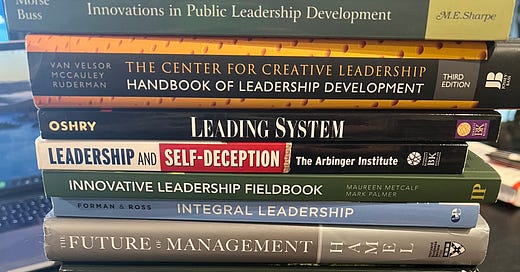Leadership schmedership. It’s an interesting topic and one I’ve studied a lot, but even with the explosion of ideas on the topic today, there is only one theory that comes up again and again for me in practice: people-focus vs task-focus.1
People-focus: The degree to which a leader considers the needs, interests, and personal development of their team members when deciding how to accomplish tasks.
Task-focus: The degree to which a leader emphasizes concrete objectives, organizational efficiency, outcomes, and high productivity when deciding how to accomplish tasks.
I first encountered this distinction when reviewing Ralph Stogdill’s Ohio State Leadership Studies that were done in the 1950s. They are some of the very first scientific studies ever conducted of the practice of management.
Stogdill (and colleagues) identified two primary dimensions of leadership behavior: 1) “Consideration,” which I would call people-focus, and; 2) “Initiating structure,” or what I would call task-focus, since they both correspond to the definitions I provided above.
But the other key finding of Stogdill’s work, and this is critically important, is that these two dimensions were relatively independent. Meaning, a leader could be high or low on both dimensions, or high on one and low on the other.
This idea was picked up in the 1960s, first by Robert R. Blake and Jane S. Mouton who developed the Managerial Grid Model (or Leadership Grid), which used two dimensions: 1) “Concern for People” (Y-Axis), i.e. people-focus, and 2) “Concern for Production” (X-Axis), i.e. task-focus.
By looking at these two variables independently, Blake & Mouton could demonstrate that an unconscious bias to either side of that polarity, could cause problems. Good leadership means caring about the people AND caring about the task. Either one could be the priority in a given moment, but fundamentally, both are necessary.
Around the same time (60s), social psychologist Douglas McGregor wrote, “The Human Side of Enterprise,” which was based on research that showed managers held two contrasting views of workers and their motivations: 1) a task-focused orientation, called, “Theory X,” which posits that employees inherently dislike work, require coercion and control, and prefer to avoid responsibility; and 2) a people-focused orientation called, “Theory Y,” that suggests that employees view work as natural, are self-motivated, seek responsibility, and can be creative in solving organizational problems.
Fast forward to more recent times, and the distinction is still doing its work. When I was studying counseling at Harvard, and before I switched over to leadership studies, my mentor Cheryl Giles introduced me to a therapeutic model she called, “push and hold.” She explained how a good counselor or therapist needs to balance supporting the client with pushing on the client. Too much of either, without enough of the other, leads to bad times. The key is to always be stabilizing. Without enough holding, you can push someone over, and without enough pushing, you lose the stabilizing forces of forward momentum (just like riding a bike).
And then a little more recently, I stumbled across Angela Duckworth, a psychology professor at the University of Pennsylvania, and her model of “Grit,” in educational settings, which features two dimensions: 1) “Support,” the level of encouragement, resources, and emotional backing provided by the environment (such as teachers, mentors, or leaders) to individuals; and 2) “Demand,” the level of expectations, challenges, and accountability imposed by the environment on individuals. Sound familiar?
Of course it does. And I think the reason we keep discovering it again and again, is that the distinction works. It’s true and it’s helpful. It seems to resonate with some perennial philosophy about masculine energy (agency, externals, task-focus) versus feminine energy (community, internals, people-focus). It also distills the essence of the debate on which is a better lever for organizational change: structural changes (task-focus) or cultural changes (people-focus)?
In the end, we must remember the second key finding was from Stogdill’s research in the 50s. Do you remember what it was? It was that the dimensions of task-focus and people-focus are relatively independent.
Meaning, a leader could be high or low on both dimensions, or high on one and low on the other. So, we should be skeptical of any leader (especially ourselves) who uses excuses like, “Well, I wish I could be more supportive, but right now I need to be demanding,” and, “I wish I could be more demanding, but right now I need to just be supportive.” It may be true. It’s possible. But only in very temporary circumstances.
Leadership means responsibility. And whether you are a formal or informal leader, or if you have a preference for dealing with the needs and interests of the people, or dealing with concrete objectives and outcomes, I don’t know of a better theory than task-focus vs people-focus to help us explain and express that responsibility.
These is just my preferred way of labeling them.





